
|
||||||||||||||||||
|
|
||||||||||||||||||
|
| ||||||||||||||||||
  
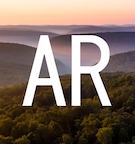


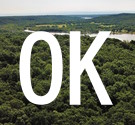

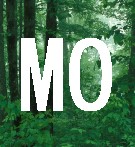
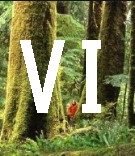



  









| ||||||||||||||||||
A Medieval Sasquatch
by Dr. W. Henner Fahrenbach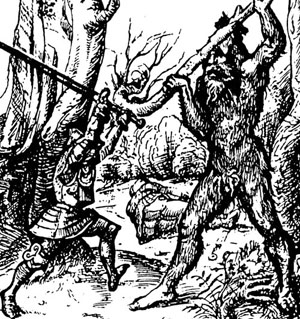 |
| "Fight in the Forest" , a woodcut by Hans Burgkmair (1473-1531). By approximation, the giant measures about 7' 3" in height with a 14" foot. |
The twelfth century saw the flowering of the troubadours in France and the Minnes?nger in Germany, Among these, Chr?tien de Troyes (ca. 1140-1190) wrote an epic "Yvain", which was recomposed in Old High German by Hartmann von Aue (ca. 1165-1210) in about 1190 as the Celtic Arthurian epic "Iwein" (pronounced "ee-vine"). In the introductory section of this rhymed poem of over 8,000 lines, a knight by name of Kalogrenant recounts an excursion he made for the sake of "?ventiure", in which the following events transpired.
Kalogrenant was riding through the wilderness of the Bretagne, an area of dense, swampy forests in northwestern France, when he came upon a clearing, in which a battle between several Wisent (Bison europaeus) and Auerochs (Bos primgenius, extinct since the 17th century) was raging. His somewhat unknightly fright was allayed when he saw a man sitting among the animals. Here follows the original text in Middle High German and my translation into English, which is kept as close to the literal meaning as possible.
|
5 10 15 20 25 30 35 40 45 50 |
Do gesach ich sitzen einen man in allmitten unter in: daz getr?ste mir den sin. d? ich aber n?her kam, und ich s?n rehte war genam, d? vorht ich in als? s?re sam diu tier, ode m?re. s?n menneschlich b?lde was anders harte wilde:. er was einem M?re gel?c michel unde als eisl?ch daz ez niemen wol beloubet. zew?re im wars s?n houbet groezer dan einem ?re. ez hete der geb?r ein ragendes h?r ruozvar: daz was im vast unde gar verwalken zuo der swarte an houbet unde an barte, s?n antl?tze was wol ellen breit, mit gr?zen runzen beleit. ouch w?ren im diu ?ren als einem waltt?ren vermieset zew?re mit spannelangem h?re, breit alsam ein wanne. dem ungev?egen manne w?ren granen unde br? lanc r?ch unde gr?; diu nase als einem ohsen gr?z, kurz, w?t, niender bl?z; daz antl?tze d?rre und vlach; - ouw? wie eisl?ch er sach! - diu augen rot, zornvar. der munt h?te im gar b?denthalp diu wangen mit w?te bevangen. er was starke gezan, als ein eber, niht als ein man: ?zerhalp des mundes t?r rageten s? im her v?r, lanc, scharpf, gr?z, breit. im was daz houbet geleit daz im s?n r?hez kinnebein gewahsen zuo den br?sten schein. s?n r?cke was im ?f gezogen, hoveroht und ?z gebogen. er truoc an seltsaeniu cleit: zw? hiute het er angeleit: die heter in niuwen stunden zwein tieren abe geschunden. er truoc einn kolben als? gr?z daz mich d? b? im erdr?z. |
There I saw a man sitting right among all of them: that caused my mind to be reassured. But when I came closer and could really observe him, I was very frightened of him as of the animals, if not more so. His human appearance was above all monstrous He looked like a moor, large and so frightful that nobody would believe it. Truly, his head was bigger than an Aueroch's. This brute had unkempt and dirty hair: It was dense and completely felted up on the skin of his head and in his beard, his face was about an ell wide, lined with large wrinkles. There were also his ears like those of a forest troll, overgrown as if by moss With hair the length of a span, Wide as a pan. This hulking man had long, scruffy and gray beard hair and eyebrows. His nose was a big as an ox's short, wide, and nowhere bare. His face lean and flat - Oh, how frightful he looked - his eyes red, angry-looking. His mouth stretched in both directions across his cheeks. He had strong teeth, like a boar, not like a man: out of the door of his mouth they stuck out, long, sharp, large and broad. His head was put on him such that his rough chin seemed to be grown to his chest. His back was curved up, hunched and bent outward. He wore peculiar clothes: two pelts he had put on: these he had just then pulled off two animals. He carried a very large club, which made me unsettled that close to him. |
Kalogrenant subsequently asks him if he means harm, but the answer is "If you don't harm me, I will be a friend" and a short conversation ensues before Kalogrenant departs. Other giants appear subsequently in the epic, but they are described as being simply large armed men with no unusual attributes other than their size.
The translation allows for many alternatives in the pertinent Middle High German dictionaries:
9) - wilde: wild, monstrous, sinister, unearthly, dreadful, creepy.
10) - M?re: moor = generic term for any black-skinned African.
11) - eisl?ch: terrible, repulsive, horrible.
15) - geb?re: word with negative connotation - lout.
16) - ruozvar: dirty, also sooty black.
20) - ellen: length of a forearm, roughly two feet.
23) - waltt?ren: German: Waldschrat = forest troll, hermit, hairy forest
giant.
25) - span: the width of a spread hand, about 9 inches.
The description of this creature has aspects rather diagnostic of sasquatches: Black skin color, hairiness, head set low on its shoulders, hunched posture. Noteworthy are the ambivalent terms with which the "monster" is referred to here and subsequently: Man, human appearance, brute, monster (G.: Ungeheuer), creature (generally reserved for animals), but also deferentially as "Sir" ("Herre"), when the knight asks him to keep the animals off his back. Needless to say, it is a dramatic description but one that deviates markedly from the run-of-the-mill giants mentioned elsewhere in the epic and may, in fact, be the first verbal description of one of the then-surviving hominids in Central Europe.
I am indebted to Peter Loughlin of Cotati, California, for pointing out the existence of this text.
-- Dr. W. Henner Fahrenbach